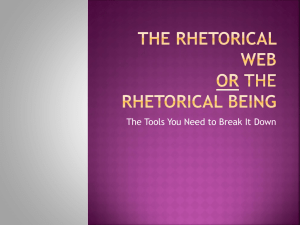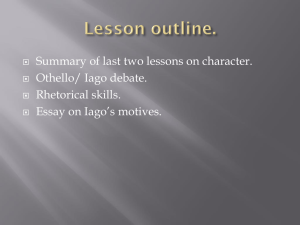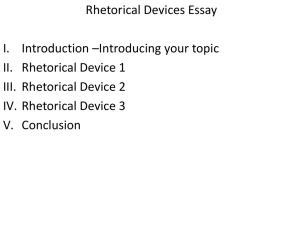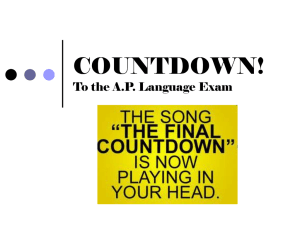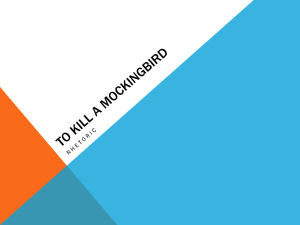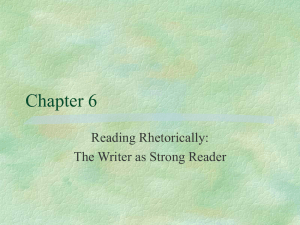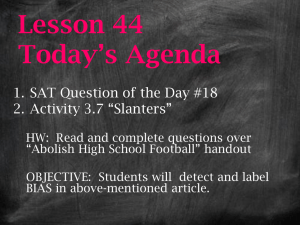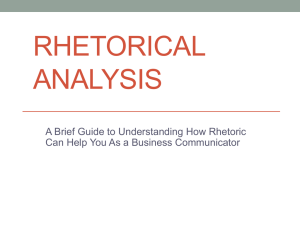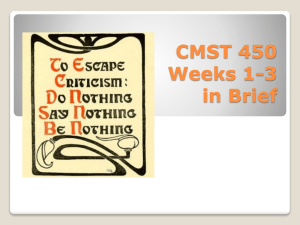Introduction to Rhetorical Analysis
advertisement
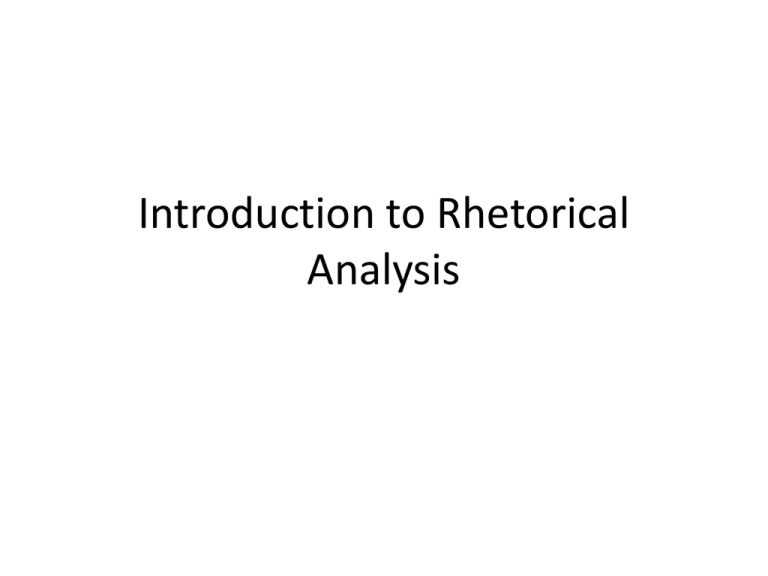
Introduction to Rhetorical Analysis Rhetorical Situation • Every day, you are surrounded by rhetoric and rhetorical opportunities. • In fact, you’ve been participating in rhetorical situations for most of your life. Daily Rhetorical Situations • Take a few minutes to list the kinds of writing you do every day. • Include all instances when you write down information, type or word process (whether on paper, white board, or computer screen). • Beside each entry, jot down the reason for that type of writing. • Be prepared to share your answers with the rest of the class. Consider three of the types of writing you identified in the first activity. • Who is your audience for these different kinds of writing? In other words, to whom or for whom are you writing? • What is your purpose for each kind of writing? • What do you hope to achieve? Choose two of the following situations and write down their similarities and differences in terms of speaker (author or writer), purpose, and audience. Be prepared to share your answers with the rest of the class. 1. It’s time for you to talk with your parents about how to pay for college—you are going to need financial help. 2. You’ve forgotten to complete a major assignment for class—without which you may fail the course. 3. Your boss needs you to draft a letter to an upset customer. 4. You’ve decided to join a competitive club at school and need to complete an application to be considered. 5. You want to apply for a job with a local restaurant. 6. You want to invite several of your friends to a large birthday celebration. Rhetorical Situation • A rhetorical situation is the context a speaker enters in order to shape an effective message that can resolve an exigence (call for change) and reach an intended audience. • A rhetorical situation creates the call for change (an exigence). • But that change can be brought about only through the use of language, whether visual, written, or spoken text. Working with a group of classmates, create a narrative story based on a rhetorical situation that your group generates. • First, you’ll need to think of an exigence (call or need for change), then include a speaker, a message, and an audience. • Then, you’ll express these elements (exigence, speaker, message, and audience) in the context of a story told either graphically (through photos or images clipped from magazines or newspapers, graphics from other sources, or your own drawings) or verbally (through words). • Be prepared to share your graphical or verbal narrative with the rest of the class and to explain it in terms of the elements of the rhetorical situation. • A rhetorical exigence is a problem or need for change that can be resolved or changed by discourse (or language). A rhetorical exigence is a problem or need for change that can be resolved or changed by discourse (or language). Decide whether each problem listed below is also a rhetorical exigence. Be prepared to share the reasoning behind your responses with the rest of the class. 1. Your high school library has just sent you a letter fining you for several overdue books, all of which you returned several weeks ago. 2. During Eid-al-Fitr, the celebratory feast after Ramadan, your brothers and father resume their ongoing argument about the political situation in the Middle East. 3. In the student seating at the football stadium, some fans throw empty soda cans, toss beach balls, boo the opposing team, and stand during most of the game. You’re quickly losing interest in attending the games. What is the Rhetorical Situation • There are 4 key relationships (to the text) you should consider when analyzing a rhetorical situation. – The speaker – The audience – The message – The exigence • The context in which the writing occurs • The culture in which the writing occurs • To the board… – Speaker – Audience – Message – Exigence What is the Rhetorical Situation • There are 4 key relationships (to the text) you should consider when analyzing a rhetorical situation. – The speaker – The audience – The message – The exigence • The call or need for change • Identifying the Rhetorical Appeals in a Document: http://www.savethechildren.org/ Analyze for: – The speaker – The audience – The message – The exigence • The call or need for change • How does the writer develop ethos? • Does the writer employ a logical appeal in this? If so, where? • What assumptions are made? • In what ways does this employ pathos? • How does it address the audience? • What is an emotional appeal? • Now I will pass out a magazine advertisement to each group. • Take about 10 minutes to address each of the key elements for rhetorically analyzing this document. • When you are done, send your group’s recorder to the board to post your findings. We’ll review them as a class and see what we agree on and what else we might want to consider. Rhetorical Analysis • Explore the rhetorical situation in this commercial. Analyze for: – The speaker – The audience – The message – The exigence • The call or need for change • What is the rhetorical situation? • How does the writer develop ethos? • Does the writer employ a logical appeal in this? If so, where? • What assumptions are made? • In what ways does this employ pathos? • How does it address the audience? What is the emotional appeal? • What argument can you make about this ad? Rhetorical Situation? • What is the rhetorical exigence? • Who is the speaker? Audience? Message? • Are there embedded stereotypes in this message? • Is the message ethically delivered? • Does this image create an argument? • Write an academic argument with your group based on this Dove advertisement. • Work together and write to create a short paper using the academic argument you have chosen. – Why is the argument you are making important, how will the reader follow the your logic, and, at the end of the argument, question whether the reader will be convinced of the argument your group has made. Homework • Bring an advertisement from home Rhetorical Situation • View Nike ads • Analyze the rhetorical situation • Write a thesis--a thesis statement should trigger discussion between at least two perspectives.
